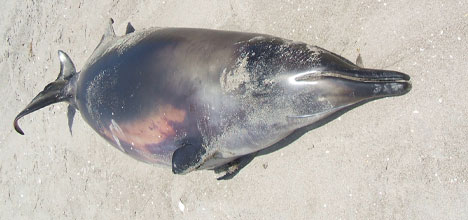Two of the world's rarest whales stranded on Opape Beach near Opotiki in December 2010, say scientists.
The mother and calf that beached on New Years Eve in 2010 have been confirmed as spade-toothed beaked whales – a discovery Auckland scientists say confirms the species still exists.
Two whales that stranded in Opotiki in 2010 were mistaken for Gray's beaked whales (pictured here) have now been identified as spade-toothed beaked whales.
'This is the first time a spade-toothed beaked whale has been seen as a complete specimen, and we were lucky enough to find two of them,” says lead scientist Dr Rochelle Constantine.
'It's incredible to think that, until recently, such a large animal was concealed in the South Pacific Ocean and shows how little we know about ocean biodiversity.”
At the time the whales were misidentified as Gray's beaked whales but scientists used DNA evidence to prove they were the first animals of their kind ever seen.
Until now the only evidence for the species' existence came from three skull and jaw fragments found around New Zealand and Robinson Crusoe Island in Chile.
The spade-toothed beaked whale was discovered on Pitt Island in the Chatham Islands in 1872, but it wasn't until 2002 that scientists from the University of Auckland analysed DNA from the three skull fragments, recovered from museum archives, and realised that their genetic profiles were the same and did not correspond to any other known species.
There was sufficient DNA evidence to confirm that these three scattered specimens were the bones of the spade-toothed beaked whale. Until the stranding, however, it was unclear whether the species still existed.
Two whales stranded and later died on Opape Beach on December 31, 2010 - a female whale 5.3m long and male calf 3.5m.
After death they were measured, photographed and tissue samples were taken by the Department of Conservation.
The whales were then identified as Gray's beaked whales, the most common beaked whale to strand in New Zealand. Subsequent genetic analysis at The University of Auckland revealed that they were spade-toothed beaked whales.
Following the genetic identification the skeletal remains were exhumed, with the permission of Whakatohea Iwi Maori Trust and the Ngai Tama Haua hapu, and taken to the Museum of New Zealand Te Papa Tongarewa.
'This is a real New Zealand story – it's all linked here, from the discovery of two of the bone fragments to the identification of the species and now the first sighting of the whales,” says Rochelle.
'In New Zealand we have a very well established network whereby members of the public report stranded marine mammals to the Department of Conservation, which collects information and sends tissue samples to our laboratory at The University of Auckland.”
'This discovery is a real reward for that work. It demonstrates the value of archival collections and the power of DNA as a forensic tool.”



0 comments
Leave a Comment
You must be logged in to make a comment.